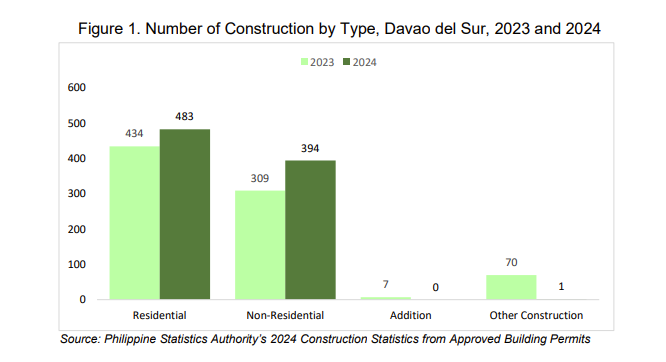
Total number of constructions from approved building permits increases by 7.1 percent
The total number of constructions from approved building permits in Davao del Sur increased by 7.1 percent, with 878 constructions recorded in 2024 from 820 constructions in 2023.
By type of construction, residential buildings recorded the highest number of constructions at 483 total number. It was an 11.3 percent increase of the total number of constructions compared to 434 in 2023. This was followed by the non-residential buildings with 394 constructions, this was a 27.5 percentage increase from 309 constructions in 2023. Construction activities involving building additions declined, with no recorded count in 2024. Similarly, other types of construction such as alterations and repairs, demolition or moving, and street furniture, landscaping, or signboard installations declined significantly by 98.6 percent, with a single project in 2024 from 70 projects in 2023 (Figure 1).
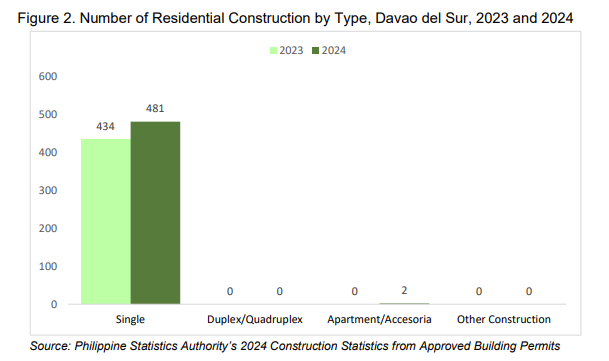
Majority residential constructions are single-type houses
In 2024, majority of residential construction from approved building permits were single-type houses. This had a total number of 481, reflecting a 10.8 percent increase from the 2023 level of 434 residential construction buildings. Additionally, apartment/accessoria recorded 2 constructions. On the other hand, other residential construction types, such as duplex/quadruplex and other residential construction such as residential condominium, had no recorded data (Figure 2).
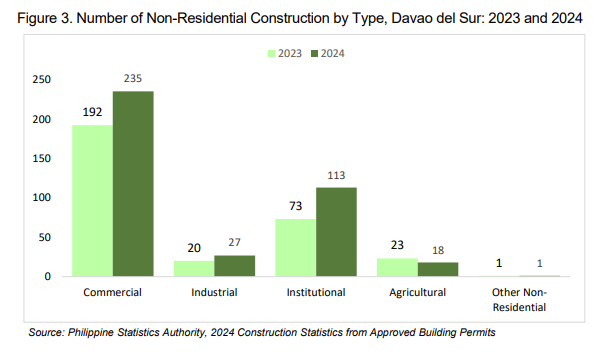
Majority of non-residential constructions are commercial types
Similarly, majority of non-residential constructions were of the commercial type at 235 approved projects. This represented a 22.4 percent increase from the 192 commercial buildings recorded in 2023. Followed by institutional buildings with 113 constructions, marking a 54.8 percent increase from 73 level in 2023.
Furthermore, industrial buildings with 27 constructions increased from 20 constructions in 2023. On the other hand, agricultural buildings recorded 18 constructions, reflecting an annual decline of 21.7 percent from the 23 in 2023. Meanwhile, the number of other non-residential remained the same with only 1 construction (Figure 3).
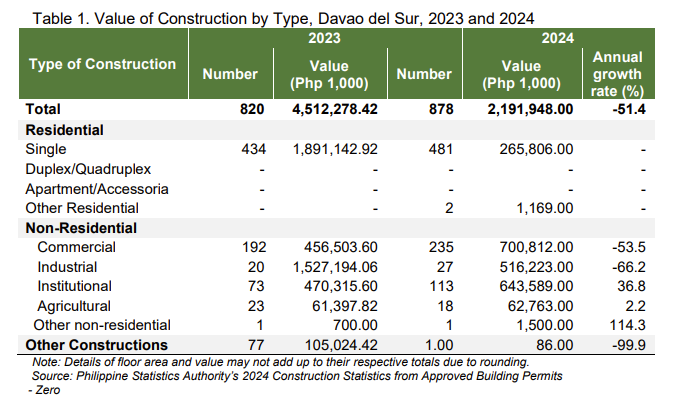
Constructions of commercial buildings record the highest value
The total value of constructions amounted to PhP2.19 billion, reflecting an annual decline by 51.4 percent from the PhP4.51 billion value of constructions in 2023.
Residential building constructions valued PhP266.97 billion. Single type houses amounted to PhP265.80 million. This indicated that residential construction was driven almost entirely by single houses. On the other hand, the construction value of non- residential buildings amounted to PhP1.92 billion or 87.8 percent of the total construction value. This reflects an increment of negative 23.5 percent from the PhP2.52 billion value of construction of non-residential buildings reported in previous year (Table 1).
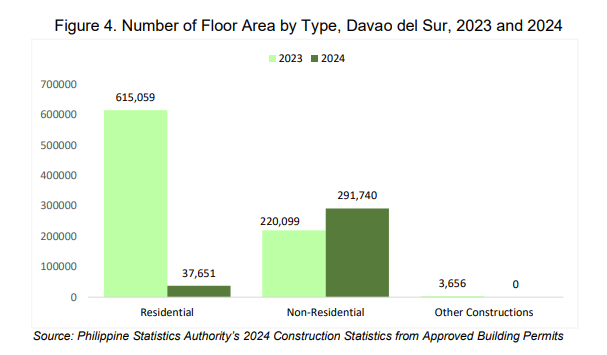
Total floor area of construction declines to 60.6 percent
The total floor area of construction recorded at 329,391 square meters. This showed an annual decline of 60.6 percent from 835,158 square meters floor area in 2023.
Non-residential constructions recorded 291,740 square meters or 88.6 percent of the total floor area. It increased at an annual rate of 32.5 percent from 220,099 square meters of the previous year. Meanwhile, residential constructions accounted for 11.3% of the total floor area, with 37,651 square meters recorded. This represented a significant decline of 93.9% compared to the 615, 059 square meters in 2023 (Figure 4).
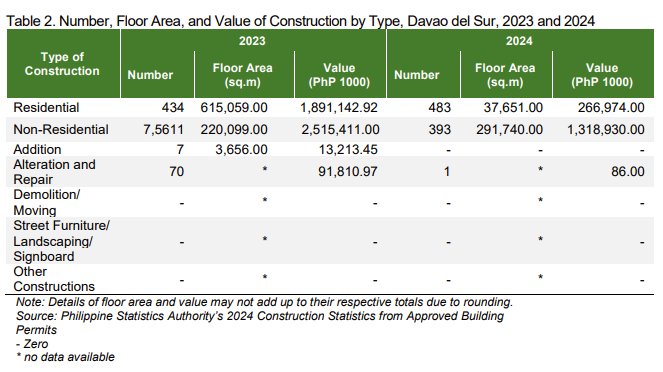
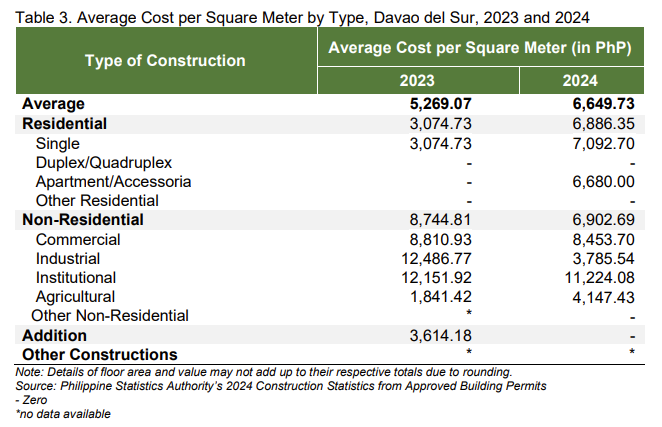
Construction of non-residential buildings have highest average cost
The average cost of construction in Davao del Sur was recorded at PhP6,649.73 per square meter. This was 26.2 percent higher than the average cost of PhP5,269.07 per square meter in 2023 (Table 3). Alteration and repair, demolition/moving, street furniture/landscaping/signboard were excluded in the average cost of construction since there was no reported floor area of these types of construction (Table 2).
By type of construction, non-residential buildings had the highest average cost of PhP6,902.69 per square meter. This was followed by a residential building with PhP6,886.35 per square meter. On the other hand, addition to existing construction there was no recorded data in 2024.
Among residential construction, single-type houses posted the highest average cost of PhP7,092.70 per square meter compared to PhP3,074.73 per square meter in 2023. Meanwhile, apartment/accessoria construction was recorded at PhP6,680 per square meter in 2024. Furthermore, across non-residential construction, institutional buildings reported the highest cost of PhP11, 224.08 per square meter, indicating a
7.6 percent decrease from PhP12,151.92 in the previous year (Table 3).
Technical Notes
The definition of term is adopted from the Revised and Updated Implementing Rules and Regulations of the National Building Code.
Building Permit is a written authorization granted by the LBO to an applicant allowing him to proceed with the construction of specific project plans after plans, specifications, and other pertinent documents have been found to be in conformity with the National Building Code.
Building refers to any independent, free-standing structure comprised of one or more rooms or other spaces, covered by a roof and enclosed with external walls or dividing walls, which extend from the foundation to the roof.
Construction refers to all on-site work done from site preparation, excavation, foundation, assembly of all the components and installation of utilities, machineries, and equipment of buildings/structures.
Residential building is a building for which its major parts or more than half of its gross floor area is built for dwelling purposes. This type of building can be of the single type, duplex, apartment and/or accessoria, and residential condominium.
- Single house is a complete structure intended for a single family or household, i.e., bungalow, 2-storey house, nipa hut, etc.
- Duplex house is a structure intended for two households, with complete living facilities for each; it is a single structure divided into two dwelling units by a wall extending from the floor to the ceiling.
- Apartment is a structure, usually of two storeys, made up of independent living quarters, with independent entrances from internal walls and courts.
- Accesoria is a one or two-floor structure divided into several dwelling units, each dwelling unit having its own separate entrance from the outside.
- Residential condominium is a structure, usually of several storeys, consisting of multiple dwelling units.
- Other residential construction consists of school or company staff houses, living quarters for drivers and maids, and guardhouses.
Non-residential buildings include commercial, industrial, agricultural, and institutional buildings.
- Commercial buildings refer to office buildings and all buildings which are intended for use primarily in wholesale, retail, and service trades; i.e., stores, hotels, restaurants, banks, disco houses, etc.
- Industrial buildings are buildings used to house the production, assembly, and warehousing activities of industrial establishments; i.e., factories, plants, mills, repair shops, machine shops, printing press, storage plants, electric generating plants.
- Institutional buildings are buildings which are primarily engaged in providing educational instructions and hospital/health care; ports, airports and other government buildings; i.e., schools, museums, libraries, sanitaria, churches, hospitals.
- Agricultural buildings are buildings used to house livestock, plants, and agricultural products such as barns, poultry houses, piggeries, stables, greenhouses, and grain mills.
- Other non-building constructions include cemetery structures, street furniture, waiting sheds, communication towers, etc.
Addition refers to any new construction which increases the height or area of an existing building/structure.
Repair is a remedial work done on any damaged or deteriorated portion/s of a building/structure to restore its original condition.
Renovation is any physical change made on structures to increase their value and quality.
Alteration is a construction in a building/structure involving changes in the materials used, partitioning and location/size of openings, structural parts, existing utilities, and equipment but does not increase the overall area thereof.
Conversion is a change in the use or occupancy of structure or any portion thereof, which has different requirements.
Demolitions refer to the systematic dismantling or destruction of a building/structure, in whole or in part.
Street furniture are street structures consisting of monuments, waiting sheds, benches, plant boxes, lampposts, electric poles, and telephone poles.
Floor area of building refers to the sum of the area of each floor of the building measured to the outer surface of the outer walls including the area of lobbies, cellars, elevator shafts, and all communal spaces in multi-dwellings. Areas of balconies are excluded.
Total value of construction refers to the sum of the cost of building, electrical, mechanical, plumbing, and others. The value is derived from the approved building permit and represents the estimated value of the building or structure when completed.
Approved for Release:
ADELINE G. BATUCAN
(Supervising Statistical Specialist)
Officer-In-Charge
Davao del Sur Provincial Statistical Office
